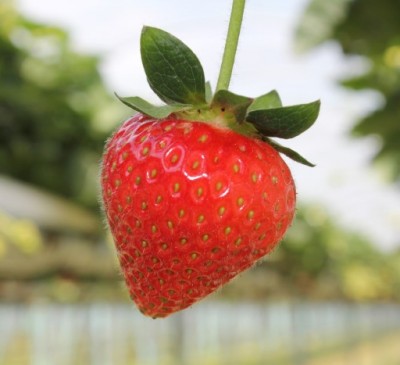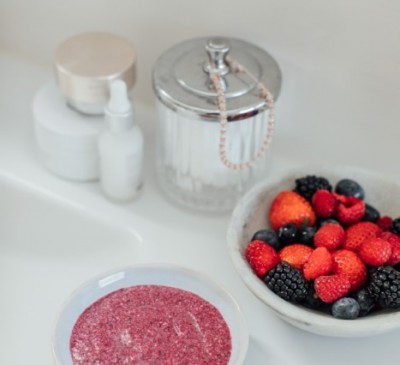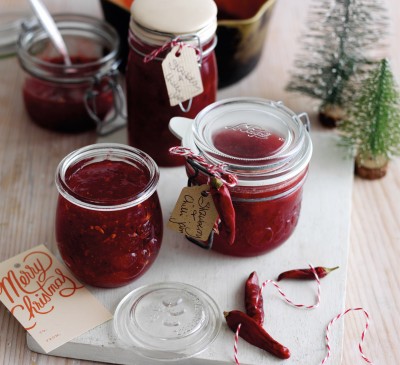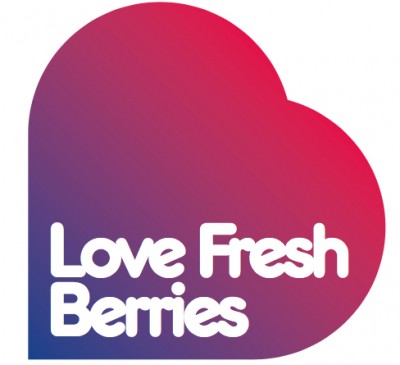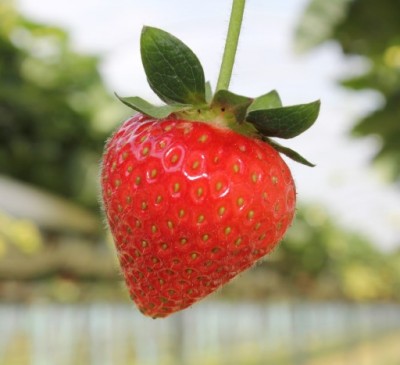
Latest News
Keep up to date with what is happening at Love Fresh Berries
If you would like more information, or comment from one of our members, please don’t hesitate to get in touch.
We’ve been working with our expert academy to talk all things berries - take a look here
Warmer winter and spring mean an early summer – British strawberries are now on supermarket shelves in abundance
13th May 2019
The British strawberry season has started earlier this year, after a warmer winter and spring have helped to speed up strawberry flowering and ripening. Strawberry lovers can enjoy their favourite British fruit right now, available to buy in supermarkets across the UK.
This summer, there are new strawberry varieties to enjoy including the large and delicious Malling Centenary, bred In Kent by the UK national berry breeding programme. Centenary has rapidly become the mainstay of early to mid-season British strawberry production and is proving as well-loved by consumers as it is by growers.
Berries have the biggest market share of all fruit grown in the UK, making up an impressive 24.5 percent, and this has pushed the value of the berry industry over £1.4 billion[i]. Fresh berries are now the most popular fruit item in shoppers’ baskets.
During the past year, more than 131,000 tonnes of strawberries were sold in the UK, with shoppers spending more than £653million on the classically British berry - an increase of 9% from 2018. Consumption of fresh raspberries has increased by 17% and blueberries by 14%.[ii]
Dr Emma Derbyshire, British Berry Growers’ public health nutritionist, explained: "Berries are a fantastic healthy snack that offer numerous health benefits. Not only is the whole strawberry rich in antioxidants, but the red fleshy part is abundant in Vitamin C. In fact, eating just nine strawberries (108g) can provide all of your recommended daily vitamin C intake.
Nick Marston, Chairman of British Berry Growers, the industry body that represents 95 percent of berries supplied to UK supermarkets said: “Ongoing innovations in our industry including the introduction of great new varieties of berries delivering sweetness and flavour, and advanced growing techniques such as large-scale glasshouse production for season extension, has meant that we can now offer shoppers the freshest, highest-quality British berries for nine months of the year.”
[i] Kantar data across 52 weeks, week ending 21st April 2019
[ii] Kantar data across 52 weeks, week ending 21st April 2019
Boost your winter skin with berries
17th Feb 2019
Our skin definitely needs some extra TLC when it’s colder; it’s coping with the cold outside and the drying central heating inside. We tend to eat less fruit during winter, which means that our antioxidant, mineral and hydration intake might suffer at the time our skin needs it the most. Love Fresh Berries has teamed up with dermatologist and skin guru Abigail James to discover why berries are a great source of skin loving nutrients and will benefit your skin all year round.
A key vitamin that appears in abundance across all berries is Vitamin C. This is a mega anti-oxidant and great when eaten and applied topically to the skin. Our bodies constantly need Vitamin C to be replaced as we don't create it ourselves in the body. It’s essential for a healthy immune system, growing and repairing tissue, wound healing, healthy bones, strengthening blood vessel walls, staving off damage from the sun’s harmful rays and is an essential ingredient to help support pigmentation issues too.
Vitamin K does not get as much attention as some other vitamins, but it’s essential for strengthening capillary walls. It prevents our arteries from calcifying and supports the blood clotting process, all essential parts of maintaining a healthy circulatory system. If our circulation is working well, our skin is being fed by fresh nutrients and oxygenated blood efficiently from our internal circulation supply. Vitamin K is a key ingredient often used in eye products because it strengthens capillary walls helping to reduce the appearance of dark circles.
Vitamin A is essential for boosting cell turnover, which helps combat the ageing process, reducing the appearance of acne, pigmentation, fine lines… the list goes on.
Minerals – magnesium, copper, potassium, zinc, iron are all found in different strengths across berries and are all essential minerals for healthy skin formation; from collagen production, healthy red and white blood cell formation, balancing hormones and helping balance oil production too.
All berries are rich in plant fibres which support a healthy gut without being an aggressive or stodgy fibre source. If our gut is healthy then our skin is going to be happy and clear.
Reinvigorate your winter skin with berries…
Raspberries have one of the highest levels of combined antioxidants - 40% more than other berries, making them good for the fight against UV damage, pollution and stressful lives.
They also contain omega 9 and have been proven to have anti-inflammatory properties due to their natural flavonoids which help protect our cells and combat inflammation. This makes them good for skin conditions such as eczema and rosacea.
Raspberry ketones have been found to reduce the production of melanin in our skin (the pigmentation). There are some sunscreens that use raspberry seed oil as a natural ingredient to help combat pigment issues with sun exposure. Raspberries are also rich in folates supporting in the formation of healthy red blood cells which carry oxygen around our bodies.
Blackberries are an ancient British berry which are made up of more than 85% water. This, coupled with all the natural fibres and nutrients makes them an amazing skin hydrator. The combined Vitamin A, C and K along with omega 3 and 6 oils in the seeds are all perfect for the skin.
Strawberries have anthocyanins which is the antioxidant that created their red colour, a great support to our circulatory system. They also have slightly astringent properties making them good for treating puffy eyes. As an alternative to the slices of cucumber, take strawberries straight from the fridge, cut them in half and glide them under the eye area.
They have natural AHA’s (alpha hydroxy acids) which are widely used within the skincare industry for their skin brightening and exfoliating effects. There are many fruit acid peels available; strawberries and blueberries are often used alongside other fruits for their skin rejuvenation effects. Strawberries might also be good for breakouts as they contain a natural form of salicylic acid which is widely used as clinical antibacterial ingredient.
Strawberries are also great for your hair and scalp, the vitamins and AHA’s help stave off dandruff whilst the high levels of Vitamin C encourage a better iron absorption which can promote healthy hair growth. Plus, because they are loaded with silica they can support split ends and thick lustrous hair too.
Blueberries have a high concentration of salicylates, the salt part of salicylic acid. Within the facial treatments at my spa, my most commonly used low level peel is actually a blueberry peel. They are great for treating all skin types, especially spot prone skins because of this natural antibacterial and anti-inflammatory effect. They are great for keeping pores clear and sloughing off dead skin cells for a smoother complexion.
Secrets To A Healthy Heart
11th Feb 2019
Our heart is the most precious organ we have and is vital to every aspect of health. Coronary Heart Disease is largely preventable, yet it currently affects over seven million people in the UK alone. In fact, over half of all adults in England have raised cholesterol levels, while one in three have high blood pressure!
It’s easy to take our heart health for granted, but by making a few simple tweaks to our diet and lifestyle we can help to protect our cardiovascular health and achieve a long and healthy life. With February being National Heart Month, there’s really no better time to start a heart friendly diet…
1. POLYPHENOLS
Whilst all fruit and veg contains an array of polyphenols, berries are unique in that they contain a high content of the polyphenol, anthocyanin, which is thought to have heart protective effects.
Data gathered from the Nurses’ Health Study showed that women who consumed the highest amounts of blueberries and strawberries were 34% less likely to suffer from a heart attack than women who ate the least of these fruits 1. What’s more, a large review of intervention trials has shown that berry consumption may reduce risk factors for cardiovascular disease (CVD) 2.
Since berries are low in calories yet rich in fibre and vitamin C 3. they can only be a good thing to add to your weekly shopping list!
TOP SOURCES: Blueberries, blackberries, strawberries, raspberries
2. VITAMIN E
Vitamin E is a fat-soluble antioxidant, which may help to prevent the development of atherosclerosis. It protects our harmful LDL cholesterol from damage and preventing its build up within blood vessel walls. Vitamin E rich foods can also help to minimise blood clots and may play a role in maintaining healthy blood pressure.
TOP SOURCES: NUTS, SEEDS, OLIVE OIL AND AVOCADO.
3. HIGH FIBRE FOODS
As a population we currently only consume a shocking and average of 15-18g fibre per day, which is just half our recommended 30g per day!
If you’re suffering with high cholesterol then soluble fibre is just too important to go amiss. This special fibre binds to ‘bad’ LDL cholesterol and bile acids in the digestive tract. This means that cholesterol is eliminated from the body rather than absorbed into the bloodstream.
We all know that wholegrains are rich in fibre, but did you know that berries such as raspberries come with a whopping 7g fibre per 100g! Get your daily fibre dose by adding raspberries to your morning porridge, smoothies, desserts or even enjoy as a tasty snack.
TOP SOURCES OF SOLUBLE FIBRE: OATS, OAT BRAN, ALL BERRIES – RASPBERRIES, BLUEBERRIES, BLACKBERRIES, STRAWBERRRIES – BEANS, LENTILS, PSYLLIUM AND FLAX SEEDS.
4. VITAMIN C
We all know that fruit and vegetables are good for us, and people who have a higher intake have been shown to have higher blood levels of vitamin C, which has been associated with a reduced risk of cardiovascular disease 4.
Vitamin C is an antioxidant nutrient and test tube, and animal studies have shown that this nutrient contributes to a reduction in the oxidation of harmful cholesterol. It may also help to maintain healthy blood pressure.
The benefits of vitamin C to heart health have not been replicated with supplements, so the key takeaway here is to always eat your five a day!
While many of us think of oranges as a top source of vitamin C, fruits such as strawberries actually have a higher concentration of this crucial vitamin! In fact, just 100g strawberries provide 100% of our recommended daily intake. Strawberries are rich in fibre, yet low in calories and sugar making them a perfect snack to balance blood sugar and keep hunger at bay.
TOP SOURCES OF VITAMIN C INCLUDE: BERRIES (PARTICULARLY STRAWBERRIES)
5. OILY FISH
All fish has been shown to support heart health, however oily fish is extra special as it’s a potent source of omega 3 fats. These healthy fats may help to protect heart and blood vessels from disease. The current government guidelines are to consume two portions of fish a week, one of which is oily.
TOP SOURCES OF OILY FISH INCLUDE: SALMON, TROUT, MACKEREL, and SARDINES & HERRING
6. POLY AND MONOUNSATURATED FATS
It may be time to put down the saturated fat-rich coconut oil and switch back to humble olive oil.
A diet high in saturated and trans fats can elevate our ‘bad’ LDL cholesterol, which can increase our risk of heart disease. Replacing saturated fats with unsaturated fats can help to maintain levels of ‘good’ HDL cholesterol and decrease levels of ‘bad’ LDL-cholesterol.
TOP SOURCES OF UNSATURATED FATS INCLUDE: OLIVE OIL, NUTS, SEEDS, AND AVOCADO
7. HERBS AND SPICES
Did you now that the UK population is currently consuming close to 9g salt per day when the maximum recommended intake is only 6g?
There’s no doubting that excess salt within the diet can cause high blood pressure, which increases the risk of stroke. Ditch the table salt and get experimenting in the kitchen with flavoursome herbs and spices!
TOP HERBS & SPICES TO TRY: TURMERIC, OREGANO, CHILLI FLAKES, CUMIN, GINGER, CARDAMOM, ROSEMARY, THYME, PARSLEY AND DILL
- https://www.ahajournals.org/doi/10.1161/CIRCULATIONAHA.112.122408
- https://www.ncbi.nlm.nih.gov/pmc/articles/PMC4804301/
- https://www.ahajournals.org/doi/10.1161/CIRCULATIONAHA.112.122408
- https://www.ncbi.nlm.nih.gov/pubmed/25948669
Lily Soutter, BSc (hons) Food & Human Nutrition, Dip NT
The Food Medic: Tips on how to reduce free sugars in the diet
6th Jan 2019
You might be thinking, hey, why all the fuss about reducing sugars? First things first, sugar is not poisonous or toxic, nor is it uniquely to blame for obesity or poor health. However, we could generally do with consuming less “free” sugars. The Scientific Advisory Committee on Nutrition (SACN), a committee of independent experts that advises the Government on nutrition issues, recommends that the average intake of FREE sugars should not exceed 5% of total dietary energy intake, as they can contribute to excess calories in our diet and tooth decay. But what are free sugars and how might we limit our intake?
Free sugars includes sugars added to food and drinks by the manufacturer, cook or consumer, but also includes ‘natural sugars’ found in honey, syrups and juices. These are sugars we generally need to eat less of as they can contribute to excess calories in our diet and tooth decay. Sugars found in fruit and vegetables, grains and cereals, or lactose naturally present in milk and dairy products are not included in this.
How can I cut down my consumption of free sugars?
Most of the free sugars we consume come from sugars that we add to food and drink, including fizzy drinks and juices, jams and condiments, biscuits, pastries and cakes. There’s no need to totally avoid these foods completely, but you can reduce the amount of free sugars in your diet by basing your meals on fibre-rich, carbohydrates such as brown rice and sweet potatoes, protein-rich beans and pulses, essential fatty acids from oily fish and flaxseed, and a variety of colourful fruit and vegetables, such as berries and leafy greens.
Here are some helpful suggestions:
- Make your own chia jam - Although there is nothing quite like old fashioned jam, it does contain quite a lot of added sugar, which isn’t great for our teeth or health if we eat too much of it. Chia seed jam is a quick, low-sugar alternative to regular jam. All you need is a punnet of berries and a tablespoon of chia seeds - You can whip this up in 5 minutes and have an incredible, homemade jam in your fridge for up to 2 weeks!
Simply stew in a pot with 2 tablespoons of water over a medium heat. Cook until the fruit breaks down and becomes syrupy, 5 to 10 minutes. Mash the berries with the back of a wooden spoon and stir in the chia seeds. Cook for another 2-3 minutes then remove from heat and let stand 5 minutes, until thickened. If you’d like a thicker consistency, especially with very juicy fruits, stir in more chia seeds 1 teaspoon at a time. Once the jam has cooled to room temperature, transfer it to a jar.
- Many breakfast cereals are quite high in sugar, including those marketed to be “healthier” options. One way to reduce your sugar intake at breakfast time is to swap to lower-sugar cereals such as plain porridge oats. You can make it just as, if not more, satisfying and delicious by jazzing it up with some warm berries, cinnamon and chopped nuts.
- Smart snacking - despite their healthy image, many cereal bars and “energy” balls are often pretty high in sugar and fat. Instead of trying to navigate the snack aisle, plan ahead and make your own snacks to take with you - it’s also a great way to save money. How about your own DIY trail mix made with a small handful of chopped nuts, fresh berries, and a square or two of dark chocolate roughly chopped?
- A large proportion of the added sugar in our diets comes from sugar sweetened beverages such as fizzy drinks and juices. If swapping to water isn’t something you feel particularly excited about, you could try flavoring it with a herbal tea bag, a handful of chopped strawberries or cucumber, or simply just mint.
- Surprisingly for some, there are also some sugar added to savoury foods - what some people call “hidden sugars” - such as in; condiments, sauces, and ready meals. This is usually to improve taste and texture but it can mean you’re consuming some extra sugar. By making your own sauces at home, and cooking from scratch as much as possible, you are likely to reduce the amount of added sugar in your meals.
2018 / 19 Top Foodie Trends
26th Nov 2018
2018 will be the year that’s remembered for its endless summer, when we*almost* won the world cup, witnessed our favourite royal tie the knot, and of course, endured endless Brexit chat. Turning our attention to the food and drink scene, Love Fresh Berries, a campaign funded by British Berry Growers, the industry body that represents berry growers in the UK, has partnered with founders of Hackney and Mayfair restaurants Pidgin and Magpie, James Ramsden and Sam Herlihy, to identify the top food and drink trends of 2018 and predictions for 2019.
According to James and Sam, flexitarianism, veganism, carbs, comfort food and fermentation were the main trends of the year. Looking ahead, we’ll be seeing more plant-based meat, Kakigori - the Japanese flavoured shaved ice dessert, powders, non-alcoholic drinks and functional foods.
2018 trends
FLEXITARIANISM - This year has seen the ongoing growth of flexitarianism as we continue to remove certain things from our diets. This is principally about removing animal protein, but also incorporates a days-of-the-week approach to going carb-/gluten-/dairy-/sugar- free.
The benefits of flexitarianism are not only around health, but also environmental and even cost – as there is a perceived financial upside of consuming less meat and fish.
Restaurants, supermarkets and food publications have responded in turn. Eating out has never been easier for those with dietary restrictions – that’s not to say there isn’t more to do, but many more restaurants are now willing to accommodate diners’ requests. The free-from range in supermarkets is growing enormously, with more and more dairy and sugar alternatives available. Food and drink producers are also following suit – the days of Becks Blue being the only 0% beer available, for example, seems a long time ago.
VEGANISM - A knock-on effect of flexitarianism has of course been the huge growth in those following vegan diets. Films such as Cowspiracy and Carnage have highlighted some of the actual and philosophical realities of the meat and dairy industry, resulting in a significant shift towards full-on veganism. The vegan trend quadrupled in the 5 years between 2012 and 2017, according to Google search[i], though it is only in the last year or two that we have seen a more concerted response from supermarkets and restaurants. Waitrose has introduced a vegan section in over 130 of its stores[ii]; Iceland has reported a 10% increase in sales of plant-based food in the past year[iii]; 2018 has also seen a steep increase in vegan-related Google searches in the UK. How much of this interest comes from the flexi community, and how much is due to full-on veganism isn’t entirely clear, but what is clear is that our use of animal products is dropping significantly - our consumption of meat has fallen by 13% since 2007.[iv]
CARBS ARE BACK - Seemingly almost as a counter-point to these first two trends, and equally as Instagram-driven (perhaps now is the time to mention the umbrella influence Instagram has over all of these trends), is the continued popularity of indulgence, with carb-heavy food leading the charge. Patisserie in particular stands out as symbolic of this trend, an artisanal angle adding foodie legitimacy to what is essentially a (delicious) onboarding of starch and sugar, though a corollary of this is the rise of artisanal bread, with a growing number of restaurants opening their own bakeries. Add to this the hysteria around certain pasta restaurants, the renaissance of the pie, the spread of doughnut vendors, and in the most extreme cases a fondness for carb-on-carb, aka beige food, and it’s clear that when we’re not on our flexi-no-gluten-no-carb-no-sugar days we’re hitting the carbs hard.
COMFORT FOOD AND DRINK - The renewed popularity of carbs is symptomatic of a broader trend towards comfort foods. As well as pies and pastries garnering so much attention, we’ve seen an almost endless parade of new restaurants cooking over wood, as comforting and atavistic a style of cookery as one can imagine. A look at the signature dishes of some of the hottest new restaurants gives an insight into this development; from Cornerstone’s brown shrimp crumpet, to roasted meats at Kym’s, to the eggs and bottarga on toast at Brat, while the rich, coconutty depths of Laksa have become one of our favourite things to eat.
Hot alcoholic drinks have come into their own, with more of us now transcending the standard mulled wine and exploring the world of eggnog, hot buttered gin, mulled berry toddies and spiced negronis.
PICKLING AND FERMENTATION - Finally a trend that we’ve seen brewing for a while but one that seems to have picked up pace this year is picking and fermentation. Pickling, preserving, fermenting and conserving tick a lot of boxes and overlap with many other trends – there’s a frugality which speaks to our growing sensitivity to food waste, there’s the practicality in these uncertain times – an assurance that there’s always food in the house – there’s the maximization of produce when it’s available to complement a plant-based diet when there may be less abundance in the fields, and there’s the straightforward fun of slowly transforming an ingredient into something else. What we’ve seen this year in particular is a shift beyond the more familiar practice of preserving vegetables into doing so with fruit in a non-jam fashion. A bumper berry crop and long growing season during 2018 has meant we’ve had to be more creative with our fruit. So fermented and pickled blueberries, raspberries, strawberries and gooseberries have featured more than they might have 10 years ago (which was, admittedly, probably not much at all).
2019 Trends
PLANT BASED ‘MEAT’ - Sales of so-called ‘plant-based meat’ increased 23% in 2018 and in 2019 we expect this trend to continue both in restaurants and also in the home. A growing move away from animal protein has coincided with advances in science and technology that have transformed meat alternatives from often dry and tasteless products into delicious meals.
These ‘meats’ are made from a variety of sources including wheat, potato or pea protein and often flavoured with heme, a soy-based molecule with the ‘flavour’ of meat. Leading products in this area are now stocked in supermarkets for consumers to cook at home.
The world’s first burger restaurant selling only these ‘bleeding’ plant-based burgers is to open in Brixton in December 2018. The Halo Burger is based around the Beyond Burger patty from the USA.
The two-site Temple Of Seitan restaurant is also primed for further expansion selling seitan (wheat gluten) based ‘fried chicken’ dishes.
KAKIGORI - Kakigori is a Japanese dessert of flavoured shaved ice. The start of its newfound rise to popularity came alongside poke bowls. Kakigori has long been popular in Hawaii having been introduced there by Japanese sugar workers.
A kakigori is made by shaving ice to a fine granular texture, mounded by hand then flavoured and decorated. Various purees, often berries or tropical fruits, are used to flavour the ice. Powders, matcha and sesame are also popular. The kakigori can then be dressed with sprinkles, jellies, syrups, condensed milk and other decorative touches.
Kakigori’s appeal is based on the adaptability of flavouring (they can also be made with savoury ingredients), the clear visual appeal and the ability for low-calorie versions to be created using alternative natural sweeteners and garnishes. High-end restaurants such as Majordomo in Los Angeles are already serving strawberry-avocado or horchata versions. Bessou in NYC serves a kakigori with three different blackcurrant preparations involved. On the more budget end of the market, Honi Poke in London serve a strawberry or a matcha syrup version.
POWDERS - The use of powdered ingredients has proliferated in 2018 but mainly when used in juicing and smoothie preparations. In 2019 the use of powders will continue to feature here with turmeric, berry powders and carob powder (an alternative to cocoa powder) particularly popular. Powders will also move more directly into the kitchen to be used by home cooks. The use of powdered teas such as green matcha, pu’er and coca leaf are seen to have health benefits but also bring out new flavours in both sweet and savoury dishes.
Consumers are also more aware of the so-called fifth flavour, umami, and powders are a simple route to add umami to food. Mushroom powder, particularly shiitake, or powdered seaweeds, enable large amounts of umami to be added to dishes without the use of more artificially created, and controversial, MSG.
Unusual spicing powders such as arima sansho, (a Japanese mix of dried and powdered sake, sugar and shoyu), will also become more widespread.
Maca powder, the powdered root of Peruvian Ginseng, will move from generally only being used as a health supplement in smoothies and health shakes, to the kitchen where it can be used to add an earthy, nutty note.
HIGH-END NON-ALCOHOLIC DRINKS AND MIXERS - There is a downward trend of adults consuming alcohol.[v] Increased knowledge of the health downsides, higher prices and a younger generation drinking less than their parents have all contributed to this.
Alcoholic beverages are being replaced with ‘soft’ botanical based drinks such as Seedlip, a non-alcoholic distilled spirit, drinking vinegars or shrubs and fruit and berry-based ferments.
Alongside this there is a move to higher quality, often lower sugar mixers to be served with traditional spirits such as gin and vodka. The huge success of Fever Tree in particular (valued at £4.5 billion July 2018) has created a more competitive market where more unusual mixers such as matcha collins mix, activated charcoal tonic and thai-basil infused soda water are becoming more widespread. The popularity of mixers is also part of a trend towards ‘longer’ style, lower alcohol drinks such as spritzes.
Kombuchas will continue their rise in popularity and move into the bartender’s pantry. Particularly popular are those incorporating more unusual fruits such as greengage, barberries and kumquat, as well as those that help to conserve a surplus of seasonal fruit.
FUNCTIONAL FOOD - Ingredients believed to directly improve health and wellbeing such as brain function and gut health, as well as foods associated with beauty, and mental wellbeing, will become more mainstream in 2019.
Research[vi] conducted by the University of Reading suggests that berries will become even more popular as consuming mixed berries in the first half of the day could sustain or improve cognitive function, accuracy and reaction time for up to six hours after consumption.
Probiotics, particularly in relation to intolerances, will become more popular. A2 dairy products in particular (dairy products with the A1 protein are believed to cause lactose intolerance) are extremely popular in many countries.
Collagen is a waste by-product from the production of gelatine. Long used in cosmetics, collagen is now being used in protein bars, drinks and broths and is believed to assist with beauty and skin health, sports nutrition, especially in injury prevention and recovery, and healthy aging. Globally there were twice as many collagen containing products brought to market in 2018 than in 2017.[vii]
While cannabis and its main psychoactive substance THC (Tetrahydrocannabinol) remains illegal in the UK, CBD (Cannabidiol - another substance contained in cannabis), is not psychoactive and is now classed as a medicine. However, it should be noted that legally claims as to its medical benefit cannot be made. Although only available currently in health food stores, expect CBD to feature in more food applications. Vegan chain By CHLOE in London recently launched a temporary range of CBD infused desserts as one example.
To summarise, we’re seeing some exciting food and drink trends emerge and it will be interesting to continue to monitor how these trends develop and help shape the way we enjoy food and drink in the future.
[i] Vegan Society. 2018. Statistics. [ONLINE] Available at: https://www.vegansociety.com/news/media/statistics. [Accessed 26 November 2018].
[ii] Plant Based Magazine. 2018. [ONLINE] Available at: https://plantbasedmag.com/waitrose-launches-dedicated-vegan-food-section-in-134-stores/ [Accessed 26 November 2018].
[iii] The Guardian. 2018 [ONLINE] Available at: https://www.theguardian.com/business/2018/jun/08/appetite-grows-vegan-products-uk-supermarkets-waitrose-iceland [Accessed 26 November 2018].
[iv] The Guardian. 2013 [ONLINE] Available at: https://www.theguardian.com/news/datablog/2013/jun/05/meat-consumption-uk-global-trends [Accessed 26 November 2018].
[v] ONS. 2018. Adult drink habits in Great Britain: 2005 – 2016. [Online] Available at: https://www.ons.gov.uk/peoplepopulationandcommunity/healthandsocialcare/drugusealcoholandsmoking/bulletins/opinionsandlifestylesurveyadultdrinkinghabitsingreatbritain/2005to2016 [Accessed 26 November 2018].
[vi] Whyte, R., Cheng, N., Lamport, D., Butler, L, & Williams,C.M. (2017) Polyphenol rich mixed berries maintain cognitive function over a 6 hour period. Nutritional Psychology Group.
[vii] Nutraceuticals World. 2018 [Online} Available at: https://www.nutraceuticalsworld.com/issues/2018-11/view_features/key-trends-in-functional-foods-beverages-for-2019/992 [Accessed 26 November 2018].
Little over six weeks till Christmas...
10th Nov 2018
With a little over six weeks till Christmas, it's maybe time to start planning those festive meals. Have a look at our Christmas recipes for inspiration.
With a little over six weeks till Christmas, it's maybe time to start planning those festive meals. Have a look at our special Christmas recipes for inspiration.
You could even make some Strawberry Chilli Jam to give to your loved ones as gifts!
New name and new website for Love Fresh Berries
23rd Oct 2018
Seasonal Berries (seasonalberries.co.uk), the campaign to promote fresh berry consumption in the UK, has been renamed to Love Fresh Berries and has a new website at lovefreshberries.co.uk.
Formerly known as Seasonal Berries (seasonalberries.co.uk), the campaign run by the grower cooperative British Berry Growers has been renamed to Love Fresh Berries, and has a new website at lovefreshberries.co.uk.
Bumper autumn for berries
16th Oct 2018
Despite cold weather setting in and Christmas looming, it seems consumers are still keen to tuck into delicious fresh berries. Berry sales have continued strongly throughout autumn, with consumers enjoying a season of mellow fruitfulness.
The past month has seen the value of the berry share of the fresh fruit market increase to 24 percent. Blueberries and raspberries have experienced the biggest growth out of all berries.
And autumn and winter months are the perfect time to enjoy the delectable berry as a pick-me-up. Dr Emma Derbyshire, British Berry Growers’ public health nutritionist, explained: "Berries are a great healthy snack that offer an abundant source of vitamins, minerals and phyto (plant) nutrients all of which have been linked to a wide range of health benefits.
“Research from the University of Reading[1] has revealed that consuming berries in the morning could sustain or improve cognitive function for up to six hours after consumption. Snacking on punnets of berries is a great and easy way to boost our fruit intake and improve concentration and cognitive performance."
Over the past year, sales of berries have increased in the UK and consumption of fresh berries has grown by over 200 percent since 2007. The rise in demand comes from an increase in the number of health-conscious Brits, who recognise the nutritional benefits berries pack for every calorie consumed. Berries now make up a remarkable 24 percent of all fruit sold in the UK, and this has pushed the value of the berry industry over £1.3 billion[2].
[1]Whyte, R., Cheng, N., Lamport, D., Butler, L, & Williams,C.M. (2017) Polyphenol rich mixed berries maintain cognitive function over a 6 hour period. School of Pscyhology and Clinical Language Sciences, University of Reading, United Kingdon.
[2] Kantar data across 52 weeks, week ending 4th November 2018
Strawberries – The Perfect Bite of Winter Vitamin C
1st Oct 2018
The clocks have gone back, our summer wardrobes have been packed away and we’re starting to plan for Christmas. It’s official, winter is here. There’s a lot to celebrate about winter but colder weather and darker days also means the start of the dreaded cold and flu season.
Dr Emma Derbyshire, registered Public Health Nutritionist, shares her top tips for how to stay healthy and keep your immune system strong this winter.
“When we layer up with jumpers and coats there is also the temptation to relax our eating habits and warm up with wintery indulgences. The good news is, there is plenty that can be done to help stay healthy this winter.
Tip 1 – Stay hydrated. Even when the weather gets colder don’t forget to drink plenty of water at regular intervals throughout the day.
Tip 2 – Avoid over-eating to warm up and try to include exercise into your daily routine.
Tip 3 – Snack on fresh fruits such as strawberries to provide a daily vitamin C boost. Strawberries also provide vitamin K, manganese, folic acid, potassium, riboflavin, vitamin B5, B6, copper, magnesium and phytonutrients so make the perfect healthy winter snack.
Tip 4 – Eat foods that naturally have a high nutrient density – fresh fruits, vegetables, nuts and seeds.
Tip 5 – Keep track of meal and snack frequency. It can be very easy for seasonal extras to creep into diets which can drive up salt and saturated fat intakes - so keep a log handy.
Berries are the perfect example of a winter snack that are full of vitamin C. For example, just 7 strawberries (80g – a portion) provide the recommended daily amount of vitamin C[1] which contributes to the normal function of the immune system along with the reduction of tiredness and fatigue.[2] Strawberries can be enjoyed on the go, used to brighten up lunchboxes or popped into reusable snack pots for a quick winter vitamin C boost.
[1] http://britishberrygrowers.org.uk/html/news_may.htm
[2] http://ec.europa.eu/food/safety/labelling_nutrition/claims/register/public/?event=search
